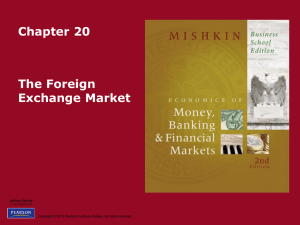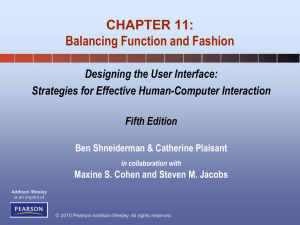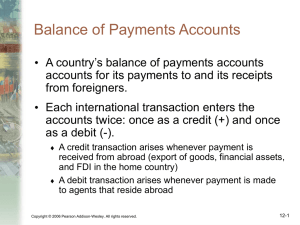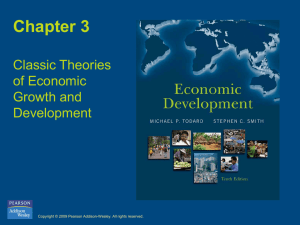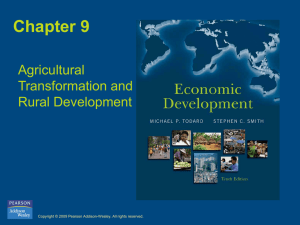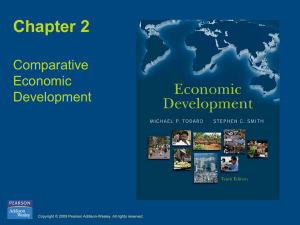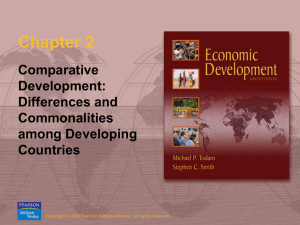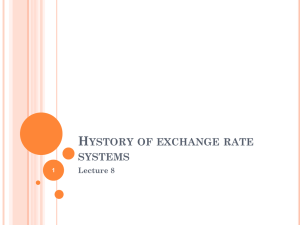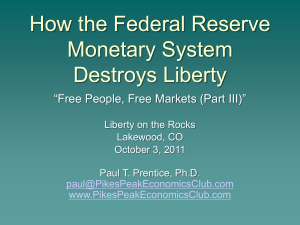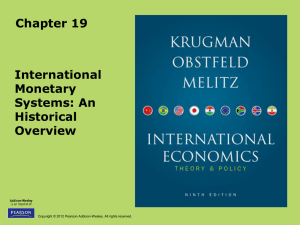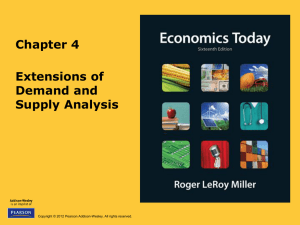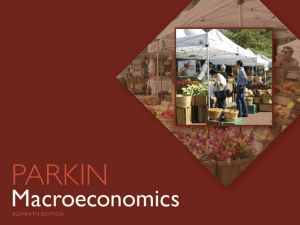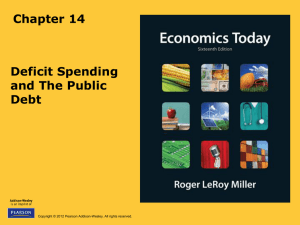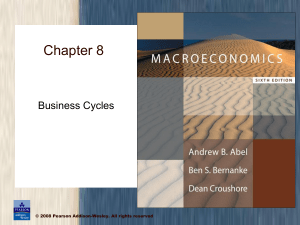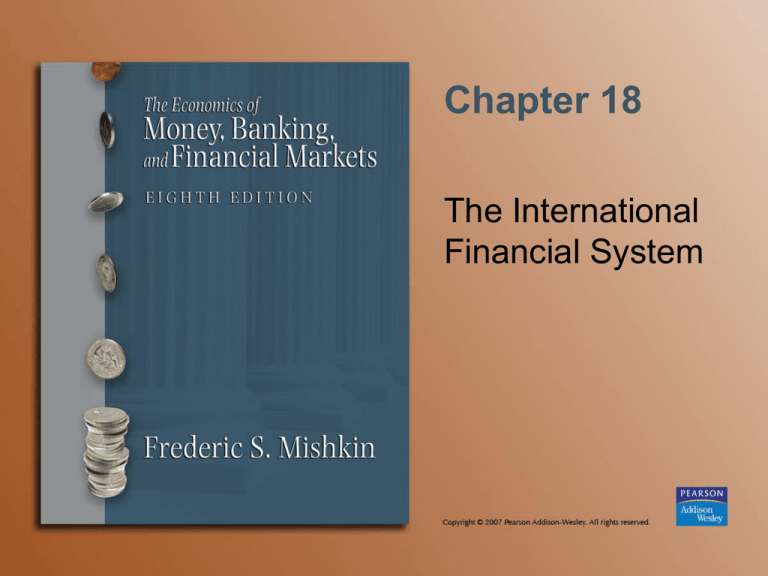
Chapter 18
The International
Financial System
Unsterilized Foreign Exchange
Intervention
Federal Reserve System
Assets
Foreign
Assets
Federal Reserve System
Liabilities
-$1B Currency in
circulation
Assets
-$1B
(International
Reserves)
Foreign
Assets
(International
Reserves)
Liabilities
-$1B Deposits
with the Fed
-$1B
(reserves)
• A central bank’s purchase of domestic currency and
corresponding sale of foreign assets in the foreign exchange
market leads to an equal decline in its international reserves and
the monetary base
• A central bank’s sale of domestic currency to purchase foreign
assets in the foreign exchange market results in an equal rise in
its international reserves and the monetary base
Copyright © 2007 Pearson Addison-Wesley. All rights reserved.
18-2
Unsterilized Intervention
• An unsterilized intervention in which
domestic currency is sold to purchase
foreign assets leads to a gain in
international reserves, an increase in
the money supply, and a depreciation
of the domestic currency
Copyright © 2007 Pearson Addison-Wesley. All rights reserved.
18-3
Copyright © 2007 Pearson Addison-Wesley. All rights reserved.
18-4
Sterilized
Foreign Exchange Intervention
Federal Reserve System
Assets
Liabilities
Foreign Assets
Monetary Base
(International Reserves)
-$1B (reserves)
Government Bonds
+$1B
0
• To counter the effect of the foreign exchange
intervention, conduct an offsetting open
market operation
• There is no effect on the monetary base and
no effect on the exchange rate
Copyright © 2007 Pearson Addison-Wesley. All rights reserved.
18-5
Balance of Payments
• Current Account
International
transactions that
involve currently
produced goods and
services
• Trade Balance
Copyright © 2007 Pearson Addison-Wesley. All rights reserved.
• Capital Account
Net receipts from
capital transactions
• Sum of these two is
the official reserve
transactions balance
18-6
Exchange Rate Regimes
• Fixed exchange rate regime
Value of a currency is pegged relative to the value
of one other currency (anchor currency)
• Floating exchange rate regime
Value of a currency is allowed to fluctuate against
all other currencies
• Managed float regime (dirty float)
Attempt to influence exchange rates by buying and
selling currencies
Copyright © 2007 Pearson Addison-Wesley. All rights reserved.
18-7
Past Exchange Rate Regimes
• Gold standard
Fixed exchange rates
No control over monetary policy
Influenced heavily by production of gold and
gold discoveries
• Bretton Woods System
Fixed exchange rates using U.S. dollar as
reserve currency
International Monetary Fund (IMF)
Copyright © 2007 Pearson Addison-Wesley. All rights reserved.
18-8
Past Exchange Rate Regimes (cont’d)
• Bretton Woods System (cont’d)
World Bank
General Agreement on Tariffs and Trade (GATT)
• World Trade Organization
• European Monetary System
Exchange rate mechanism
Copyright © 2007 Pearson Addison-Wesley. All rights reserved.
18-9
Copyright © 2007 Pearson Addison-Wesley. All rights reserved.
18-10
Copyright © 2007 Pearson Addison-Wesley. All rights reserved.
18-11
How a Fixed Exchange Rate
Regime Works
• When the domestic currency is overvalued,
the central bank must purchase domestic
currency to keep the exchange rate fixed, but
as a result, it loses international reserves
• When the domestic currency is undervalued,
the central bank must sell domestic currency
to keep the exchange rate fixed, but as a
result, it gains international reserves
Copyright © 2007 Pearson Addison-Wesley. All rights reserved.
18-12
How Bretton Woods Worked
• Exchange rates adjusted only when experiencing a
‘fundamental disequilibrium’ (large persistent deficits in
balance of payments)
• Loans from IMF to cover loss in international reserves
• IMF encourages contractionary monetary policies
• Devaluation only if IMF loans are not sufficient
• No tools for surplus countries
• U.S. could not devalue currency
Copyright © 2007 Pearson Addison-Wesley. All rights reserved.
18-13
Managed Float
• Hybrid of fixed and flexible
Small daily changes in response to market
Interventions to prevent large fluctuations
• Appreciation hurts exporters and employment
• Depreciation hurts imports and
stimulates inflation
• Special drawing rights as substitute for gold
Copyright © 2007 Pearson Addison-Wesley. All rights reserved.
18-14
European Monetary System
• 8 members of EEC fixed exchange rates with
one another and floated against the U.S. dollar
• ECU value was tied to a basket of specified
amounts of European currencies
• Fluctuated within limits
• Led to foreign exchange crises involving
speculative attack
Copyright © 2007 Pearson Addison-Wesley. All rights reserved.
18-15
Capital Controls
• Outflows
Promote financial instability by forcing
a devaluation
Controls are seldom effective and may increase
capital flight
Lead to corruption
Lose opportunity to improve the economy
• Inflows
Lead to a lending boom and excessive risk taking
by financial intermediaries
Copyright © 2007 Pearson Addison-Wesley. All rights reserved.
18-16
Capital Controls (cont’d)
• Inflows (cont’d)
Controls may block funds for productions uses
Produce substantial distortion and misallocation
Lead to corruption
• Strong case for improving bank regulation
and supervision
Copyright © 2007 Pearson Addison-Wesley. All rights reserved.
18-17
The IMF: Lender of Last Resort
• Emerging market countries with poor
central bank credibility and short-run
debt contracts denominated in foreign
currencies have limited ability to engage
in this function
• May be able to prevent contagion
• The safety net may lead to excessive
risk taking (moral hazard problem)
Copyright © 2007 Pearson Addison-Wesley. All rights reserved.
18-18
How Should the IMF Operate?
• May not be tough enough
• Austerity programs focus on tight
macroeconomic policies rather than
financial reform
• Too slow, which worsens crisis and
increases costs
Copyright © 2007 Pearson Addison-Wesley. All rights reserved.
18-19
Direct Effects of the Foreign Exchange
Market on the Money Supply
• Intervention in the foreign exchange
market affects the monetary base
• U.S. dollar has been a reserve currency:
monetary base and money supply is less
affected by foreign exchange market
Copyright © 2007 Pearson Addison-Wesley. All rights reserved.
18-20
Balance-of-Payments Considerations
• Current account deficits in the U.S.
suggest that American businesses may
be losing ability to compete because the
dollar is too strong
• U.S. deficits mean surpluses in other
countries large increases in their
international reserve holdings
world inflation
Copyright © 2007 Pearson Addison-Wesley. All rights reserved.
18-21
Exchange Rate Considerations
• A contractionary monetary policy will
raise the domestic interest rate and
strengthen the currency
• An expansionary monetary policy
will lower interest rates and
weaken currency
Copyright © 2007 Pearson Addison-Wesley. All rights reserved.
18-22
Advantages of
Exchange-Rate Targeting
• Contributes to keeping inflation
under control
• Automatic rule for conduct of
monetary policy
• Simplicity and clarity
Copyright © 2007 Pearson Addison-Wesley. All rights reserved.
18-23
Disadvantages of
Exchange-Rate Targeting
• Cannot respond to domestic shocks and
shocks to anchor country are transmitted
• Open to speculative attacks on currency
• Weakens the accountability of
policymakers as the exchange rate loses
value as signal
Copyright © 2007 Pearson Addison-Wesley. All rights reserved.
18-24
Exchange-Rate Targeting
for Industrialized Countries
• Domestic monetary and political
institutions are not conducive to good
policy making
• Other important benefits such
as integration
Copyright © 2007 Pearson Addison-Wesley. All rights reserved.
18-25
Exchange-Rate Targeting
for Emerging Market Countries
• Political and monetary institutions
are weak
• Stabilization policy of last resort
Copyright © 2007 Pearson Addison-Wesley. All rights reserved.
18-26
Currency Boards
• Solution to lack of transparency and
commitment to target
• Domestic currency is backed 100% by a
foreign currency
• Note issuing authority establishes a fixed
exchange rate and stands ready to exchange
currency at this rate
• Money supply can expand only when foreign
currency is exchanged for domestic currency
Copyright © 2007 Pearson Addison-Wesley. All rights reserved.
18-27
Currency Boards (cont’d)
• Stronger commitment by central bank
• Loss of independent monetary policy
and increased exposure to shock from
anchor country
• Loss of ability to create money and act as
lender of last resort
Copyright © 2007 Pearson Addison-Wesley. All rights reserved.
18-28
Dollarization
• Another solution to lack of transparency
and commitment
• Adoption of another country’s money
• Even stronger commitment mechanism
• Completely avoids possibility of speculative
attack on domestic currency
• Lost of independent monetary policy
and increased exposure to shocks from
anchor country
Copyright © 2007 Pearson Addison-Wesley. All rights reserved.
18-29
Dollarization (cont’d)
• Inability to create money and act as lender
of last resort
• Loss of seignorage
Copyright © 2007 Pearson Addison-Wesley. All rights reserved.
18-30




